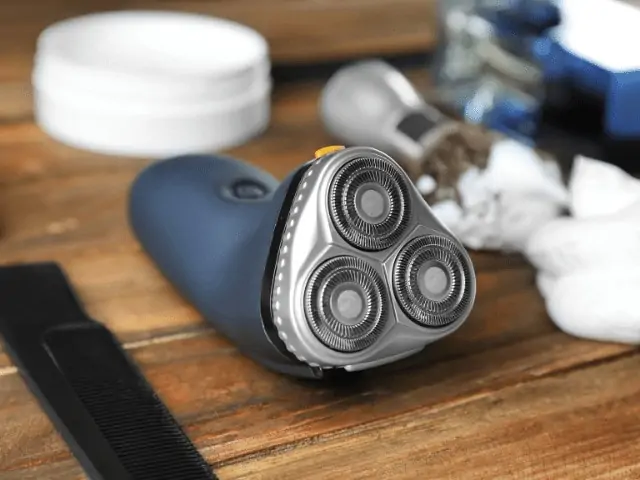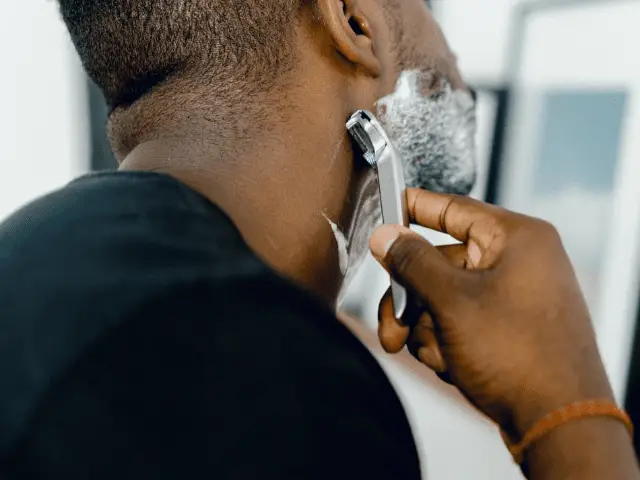Over time, even the most advanced electric razor blades can lose their cutting edge, leading to less-than-satisfactory results. Dull blades can cause irritation, nicks, and an uneven shave.
This is where sharpening electric razor blades becomes necessary. Whether you're a seasoned grooming enthusiast or just looking to prolong the life of your electric or safety razor blade, we’ll share insights into how to keep your electric razor performing at its best.
Page Contents
- Understanding Electric Razor Blades
- Preparation for Sharpening: Setting the Stage for Blade Revival
- Step-by-Step Electric Razor Blade Sharpening Process
- Tips for Achieving Optimal Results
- Common Mistakes to Avoid
- Testing and Maintenance: Fine-Tuning for Lasting Sharpness
- How Often to Sharpen Electric Razor Blades
- Proper Blade Maintenance After Sharpening
- Bottom Line
- FAQs
- How can I tell if my electric razor blades need sharpening?
- Can I use the same sharpening method for both foil and rotary blades?
- Is it possible to over-sharpen electric razor blades?
- How often should I oil my electric razor blades after sharpening?
- Can I use household items to sharpen my electric shaver blades?
Understanding Electric Razor Blades
Electric razors come in two distinct forms – foil blades and rotary blades. The first variant has sleek and precise blades. Foil blades are known for their thin, perforated foil covering. The blades move back and forth, capturing and shaving hair as the razor glides onto the skin.
It is ideal for people with sensitive skin, foil shaver machines offer precision and elegance.
Rotary blades work as trios. These spinning circular razor blades follow the undulating contours of your face. They tackle longer hairs and for close shaving. They're perfect for those blessed with thicker beards.
No matter the type, the longevity of electric razor blades inevitably wanes, and recognizing when they've dulled is paramount. As your blades lose their edge, they may begin to tug and pull at your hair rather than effortlessly gliding through it.
This can lead to skin irritation, redness, razor burn, and itching.
You’ll also notice uneven results, patches of unshaved hair, and a less-than-flawless finish.
This is when your razor blade needs sharpening!
Sharpening isn't just a boon for your grooming routine. It's a smart financial move too, helping you extend the lifespan of your blades. Also, by sharpening and reusing your blades, you'll be doing your bit for the environment by reducing wastefulness.
Preparation for Sharpening: Setting the Stage for Blade Revival
To ensure success in your blade-sharpening efforts, you must first gather the essential tools and materials. A comprehensive sharpening kit is a wise investment, and sometimes, you can get something specifically suited for your electric razor model.

Also, make sure that you have a clean, flat surface to work on, as well as a soft cloth for wiping the blades and maintaining cleanliness throughout the process. When everything is set, you can get started with sharpening your razor blade.
But before you do, you need to take care of a couple more things:
Clean the Razor Blades
A crucial step in the sharpening process is ensuring that your shaving head blades are impeccably clean. Begin by removing any hair and debris from the blades using a brush or a specialized cleaning tool provided with your razor.
Afterward, gently rinse the blades with warm water to remove the remaining residue, taking care not to damage them. Once you’re done cleaning, pat the blades dry with a clean, lint-free cloth, ensuring that they are entirely free of moisture.
Follow Through with the Safety Precautions
Safety should always be paramount when working with electric shaver blades. Unlike a straight razor, you need to make sure that the electric shaver is disconnected from any power source before you begin sharpening.
Also, exercise caution when handling sharp objects. Use the appropriate safety gear, such as gloves and safety glasses, to protect your hands and eyes.
Keep your workspace well-lit and organized to minimize the risk of accidents.
Familiarize yourself with the specific safety guidelines provided by your razor's manufacturer and the sharpening kit instructions (if you’re using one) for safely and effectively sharpening heads.
Step-by-Step Electric Razor Blade Sharpening Process
If you're using a sharpener kit, here’s how you can sharpen your shavers in a pinch:
- Disassemble the shaver head and take out the blades safely.
- Next, apply the sharpening solution to the blades (you can also use toothpaste).
- Use a small brush (or a toothbrush) to clean the blades.
- Work the blades in a controlled manner.
- Do this until the surface oxidation is off and your blade comes out sharp.
- Rinse the razor and then pat it dry with a soft cloth.
Tips for Achieving Optimal Results
Achieving optimal results during the shaving process requires finesse, attention to detail, and optimal sharpness.
Here are some tips to help you enhance your sharpening experience:
- Use light pressure: Avoid applying excessive force, as it can damage the blades or produce uneven results. Let the sharpening method work as it should.
- Regularly check progress: Pause periodically to assess the blades' sharpness. This way, you can prevent over-sharpening, which can also be detrimental.
- Keep the blades clean: Wipe the blades with a clean cloth when you sharpen razor blades to remove any metal particles and maintain visibility of your progress.
Common Mistakes to Avoid
Some easily avoidable mistakes during the shaving process can undermine your efforts:
- Sharpening shaver blades beyond what's necessary can lead to premature wear and, ironically, dullness.
- Failing to keep the razor's shaving head and workspace clean can introduce contaminants that affect the shaving process.
- Impatience can lead to hasty sharpening, which often yields subpar results. Take your time and proceed methodically.

Follow the method-specific instructions, implement these tips, and avoid common pitfalls. This way, you can sharpen your best electric shaver blades, to ensure close and comfortable shaving with each use.
Testing and Maintenance: Fine-Tuning for Lasting Sharpness
Once the sharpening process is complete, you must evaluate the sharpness of your electric shavers blades. Gently run your fingertip over the blade edges to assess their smoothness and keenness.
If the blades feel significantly sharper than before and glide effortlessly across your skin, you're on the right track.
You can perform a test shave on a small, inconspicuous area.
This way, you can ensure that the blades deliver the expected results. Regular testing helps you gauge when it's time for another sharpening session.
How Often to Sharpen Electric Razor Blades
The frequency of sharpening your electric razor blades largely depends on your usage habits and the blade type.
Foil blades generally require less frequent sharpening compared to rotary shaver blades.
Consider sharpening your shaving head every few months or when you notice a decline in shaving performance. This timeframe can vary, so it's essential to rely on the sharpness assessment and the feel of your shave as indicators for when it's time to sharpen again.
Proper Blade Maintenance After Sharpening
Maintaining the sharpness of your electric razor blades goes beyond the sharpening process itself. After each use, you must gently brush or blow away any remaining hair or debris from the blades to prevent buildup.
Regularly cleaning and oiling your blades with a specialized razor lubricant can help maintain their sharpness and prolong the time between sharpening sessions.
Store your electric razor in a clean, dry, and protected environment.
This way, you can prevent dust and contamination.
By regularly checking the sharpness, determining the optimal sharpening frequency, and practicing diligent blade maintenance, you can ensure that your electric shaver blades remain sharp and provide you with a consistently smooth and comfortable shaving experience.
Bottom Line
Sharpening electric shaver blades is a crucial skill to learn for all men. Navigate the nuances of blade types, follow different sharpening procedures, and embrace blade razor maintenance. Soon enough, you’ll unlock the potential for a consistently close and comfortable shave.
Bringing out the perfect blade sharpness requires patience, precision, and periodic testing. And it’ll be all worth it – it will ultimately lead to a grooming routine characterized by sharpness, comfort, and confidence.
Hopefully, you and your razor will go hand in hand for the long run if you keep it up!
FAQs
How can I tell if my electric razor blades need sharpening?
Signs of dull blades include tugging or pulling during shaving, increased skin irritation, uneven results, and a slower shave. These indicators suggest that it's time for sharpening.
Can I use the same sharpening method for both foil and rotary blades?
While some methods are versatile, you must follow the specific instructions for each blade type, as foil and rotary blades have distinct sharpening requirements.
Is it possible to over-sharpen electric razor blades?
Yes, over-sharpening can lead to premature blade wear and a less effective shave. You must follow the recommended sharpening frequencies and techniques to avoid this issue.
How often should I oil my electric razor blades after sharpening?
It's advisable to oil your blades after every use to maintain their sharpness and reduce friction. A specialized razor lubricant is ideal for this purpose.
Can I use household items to sharpen my electric shaver blades?
Yes. DIY methods involve household items like denim fabric, toothpaste, or abrasive compounds. While they may sharpen a shaver head, it's crucial to follow proper instructions and exercise caution to avoid damaging your blades.



